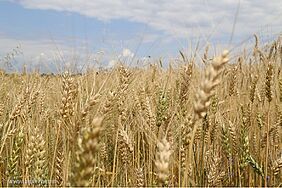Plant seed oil is a highly useful and important bioresource. It has a wide variety of applications, ranging from being an essential part of human nutrition to being used as industrial feedstock. Many plant species produce and store triacylglycerol (TAG) in their seeds, which is mainly used as a carbon and energy source to support seedling development. However, increasing the sugar content in oilseed crops can, under certain circumstances, lead to an enhanced oil content which can in turn be harnessed for biofuel production.
Now (2021), scientists from Brookhaven National Laboratory (BNL) have propagated a plant that is able to generate more oil by increasing the amount of sugar readily available for oil synthesis. This was achieved by using the leaves of the fast-growing plant Arabidopsis to mimic stem cells of plants like energy cane and miscanthus to get an abundant and sustainable supply of oil that can be used to produce biodiesel, biojet fuel, and bioproducts.
The current project is based on earlier research conducted in 2017, which showed that simultaneously inhibiting the export of sugar from leaves while blocking starch synthesis could redirect sugars produced by photosynthesis and use them for fatty acid and oil synthesis. The scientists took mutants of Arabidopsis (Arabidopsis thaliana) and the expression of oleogenic factors to research the interaction among sugar availability, lipid synthesis, and the accumulation of triacylglycerol (TAG) in the tissue of the leaves. Their findings provided valuable insights into how sugar, fatty acids, and TAG accumulation in vegetative tissues functioned which, they hoped, would help optimise TAG accumulation in vegetative tissues of economically important plants.
In view of these results, the aim of the recent follow-up study was to reduce sugar accumulation in a large cellular storage compartment called the vacuole. This was achieved by blocking sugar movement into the vacuole and maximising its export. When these genetic manipulations took place in plants, which also had reduced starch synthesis, the cell started converting the excess sugar into oil. To this end, Arabidopsis was crossed with tonoplast monosaccharide transporter mutants and overexpression of the sucrose/proton cotransporter where sugar transport to the vacuole from the cytoplasm was impaired and overexpression enhanced sugar transport from the vacuole to the cytoplasm. Once these findings get validated through a model system, the knowledge could be used for slower-growing biomass crop plants so that the availability of sustainable biofuels would be increased and the use of petrochemicals reduced.
Oilseed crop improvement has also been the aim of other research efforts. In 2019, for example, scientists studied the ketide synthase domain from the polyunsaturated fatty acid synthase in Arabidopsis thaliana to find out what its capacity of oil production was. The researchers found that the plastidial expression of the ketide synthase domain could complement the defective phenotypes of the knockout mutant of β-Ketoacyl-[acyl carrier protein] synthase I, which plays a crucial role in plant growth and fatty acids synthesis and is generated by the plant DNA sequence CRISPR/Cas9 microbial adaptive immune system. The research results showed that seed-specific expression of the domain in wild-type Arabidopsis significantly increased seed weight and seed oil as well as altered the unsaturation level of fatty acids in seeds and promoted seed germination and early seedling growth.
Propogating energy crops where the sugar is redirected to increase the oil content has several advantages: the remobilised sugar leads to a decrease in the growth delays when the amount of exported sugar from the leaves and starches is reduced. Also, the team found that it was more difficult to make multiple gene manipulations in energy cane, whereas with Arabidopsis they could quickly develop and test different genetic and molecular biology modifications to find the most effective combinations.
The scientists are convinced that the positive research results gained from their model plant proves that their technique has great potential and could be applied to common crops like energy cane and miscanthus so that they can easily be turned into viable sources for conversion into biodiesel and biojet fuel.
